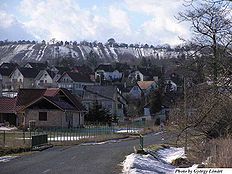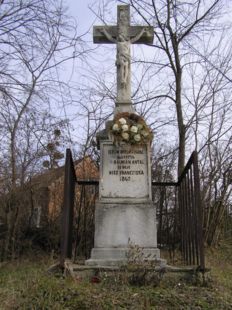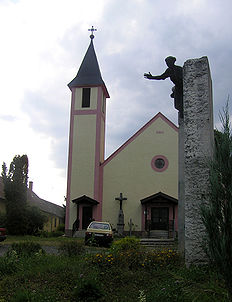
Bocfölde
Encyclopedia

Hungary
Hungary , officially the Republic of Hungary , is a landlocked country in Central Europe. It is situated in the Carpathian Basin and is bordered by Slovakia to the north, Ukraine and Romania to the east, Serbia and Croatia to the south, Slovenia to the southwest and Austria to the west. The...
. It has a growing commuter community that works in Zalaegerszeg
Zalaegerszeg
In 2001 Zalaegerszeg had 61,654 inhabitants . The distribution of religions were, 71.1% Roman Catholic, 3.8% Calvinist, 1.6% Lutheran, 11.6% Atheist .-Notable people:* Lajos Botfy , mayor...
, the county seat and regional industrial center that is located about 6 km (4 mi) to the North.
Location, Geography
Bocfölde is settled on the left bank of the Válicka a small river originating in the Southwest of Zala County and merging into the Zala RiverZala River
The Zala is a river in south-western Hungary. Its source is in the hills on the borders with Austria and Slovenia. Its length is 139 km and drains water from 2,622 square km...
. Zalaegerszeg
Zalaegerszeg
In 2001 Zalaegerszeg had 61,654 inhabitants . The distribution of religions were, 71.1% Roman Catholic, 3.8% Calvinist, 1.6% Lutheran, 11.6% Atheist .-Notable people:* Lajos Botfy , mayor...
is to the North, village of Csatár
Csatár
Csatár is a village in Zala county, Hungary.-References:...
(1 km) is to the East, and Sárhida
Sárhida
Sárhida is a village in Zala county, Hungary.-References:...
(2 km) is to the South. Roads crossing the hills of Bocfölde to the valley on the West could be safely ridden only by four-wheel drive
Four-wheel drive
Four-wheel drive, 4WD, or 4×4 is a four-wheeled vehicle with a drivetrain that allows all four wheels to receive torque from the engine simultaneously...
vehicles. Older houses were built on the Zala Hills overlooking the Válicka Valley, whereas from the 1960s a new settlement developed in the Valley itself. Here, European route E65
European route E65
European route E 65 is a north-south Class-A European route that begins in Malmö, Sweden and ends in Chaniá, Greece. The road is about in length.-Itinerary:* Sweden** E 65: Malmö – Ystad* Baltic sea, ferry Ystad-Świnoujście* Poland...
, a local road connecting to Zalaegerszeg
Zalaegerszeg
In 2001 Zalaegerszeg had 61,654 inhabitants . The distribution of religions were, 71.1% Roman Catholic, 3.8% Calvinist, 1.6% Lutheran, 11.6% Atheist .-Notable people:* Lajos Botfy , mayor...
-Sárhida
Sárhida
Sárhida is a village in Zala county, Hungary.-References:...
-Bak
Bak
Bąk may refer to the following places:*Bąk, Kuyavian-Pomeranian Voivodeship *Bąk, Gmina Karsin in Pomeranian Voivodeship *Bąk, Gmina Stara Kiszewa in Pomeranian Voivodeship *Bąk...
, and the Zalaegerszeg
Zalaegerszeg
In 2001 Zalaegerszeg had 61,654 inhabitants . The distribution of religions were, 71.1% Roman Catholic, 3.8% Calvinist, 1.6% Lutheran, 11.6% Atheist .-Notable people:* Lajos Botfy , mayor...
-Rédics
Rédics
Rédics is a village in Zala county, Hungary.Recently a video posted on youtube of Reverend Zoltan Lendvai skateboarding clad in full clerical garb has made international headlines.-References:http://www.bbc.co.uk/news/world-europe-10993749...
railway provide convenient access to the rest of the region.
Bocfölde is part of Göcsej
Göcsej
Göcsej is a geographic and ethnic region within Zala County, Hungary, containing these settlements :BabosdöbréteBakBaktüttösBarlahidaBecsvölgyeBocföldeBödeCsonkahegyhátDobronhegyGellénházaGombosszegHottóIborfiaKustánszeg...
, a geographic, historical, architectural, and ethnographic unit, that maintained elements of a unique agricultural culture until 1950s and 1960s, when industrialization and modernization accelerated. Göcseji Falumúzeum, a reconstructed model village displaying original houses, agricultural buildings collected from the Göcsej
Göcsej
Göcsej is a geographic and ethnic region within Zala County, Hungary, containing these settlements :BabosdöbréteBakBaktüttösBarlahidaBecsvölgyeBocföldeBödeCsonkahegyhátDobronhegyGellénházaGombosszegHottóIborfiaKustánszeg...
region is nearby in Zalaegerszeg
Zalaegerszeg
In 2001 Zalaegerszeg had 61,654 inhabitants . The distribution of religions were, 71.1% Roman Catholic, 3.8% Calvinist, 1.6% Lutheran, 11.6% Atheist .-Notable people:* Lajos Botfy , mayor...
.
History
Its first recorded name, in 1247, is "Possessio Buchfelden". Its stone church, mentioned in a 1426 document, was dedicated to Saint Margaret of HungarySaint Margaret of Hungary
Saint Margaret was a nun and the daughter of King Béla IV and Maria Laskarina. She was the niece of Saint Elizabeth of Hungary and the younger sister of Saint Kinga and Blessed Yolanda.-Early life:...
. The church and the entire village were destroyed in the 17th Century. Its decline started after the Ottoman
Ottoman Empire
The Ottoman EmpireIt was usually referred to as the "Ottoman Empire", the "Turkish Empire", the "Ottoman Caliphate" or more commonly "Turkey" by its contemporaries...
army won a major battle against the Hungarians at Mohács
Mohács
Mohács is a town in Baranya county, Hungary on the right bank of the Danube.-History:Two famous battles took place there:# Battle of Mohács, 1526# Battle of Mohács, 1687...
in 1526. As the Ottoman troops used the Kanizsa-Sopron
Sopron
In 1910 Sopron had 33,932 inhabitants . Religions: 64.1% Roman Catholic, 27.8% Lutheran, 6.6% Jewish, 1.2% Calvinist, 0.3% other. In 2001 the city had 56,125 inhabitants...
-Vienna
Vienna
Vienna is the capital and largest city of the Republic of Austria and one of the nine states of Austria. Vienna is Austria's primary city, with a population of about 1.723 million , and is by far the largest city in Austria, as well as its cultural, economic, and political centre...
road, which crossed the village, for several military campaigns, Bocfölde settlement was deserted. The village became completely exposed in 1571 when the Ottoman troops occupied the nearby defensive fort of Kanizsa, now Nagykanizsa. The village was resettled, away from the Kanizsa-Sopron
Sopron
In 1910 Sopron had 33,932 inhabitants . Religions: 64.1% Roman Catholic, 27.8% Lutheran, 6.6% Jewish, 1.2% Calvinist, 0.3% other. In 2001 the city had 56,125 inhabitants...
road, in the relative protection of surrounding forested hills, after the end of Ottoman occupation in the late 17th century. By 1826 its population, made up by families of small land owners, grew to 413 residents of 56 households.
Demographics
Ethnic composition: 86.7% Hungarian, 6.3% Roma, 8.3% unknown/no response (2001 Census).Religious affiliations: 74% Roman Catholic, 1.1% Reformed Christian, 0.5% Evangelical, 6.9% no affiliations, 17.3% no response (2001 Census).
Sites of interest
- ~500 year old European Chestnut tree (Castanea sativa)
- ~110 year old Small-leaved Lime tree (Tilia cordataTilia cordataTilia cordata is a species of Tilia native to much of Europe and western Asia, north to southern Great Britain , central Scandinavia, east to central Russia, and south to central Spain, Italy, Bulgaria, Turkey, and the Caucasus; in the south of its range it is restricted to...
) - Herds of Hungarian Grey CattleHungarian Grey CattleHungarian Grey Cattle or Hungarian Steppe Cattle are an old beef cattle breed from Hungary....
and Murakoz horseMurakoz horseThe Murakoz is a medium-sized draft horse with a kind temperament, strength and a willingness to work. It was developed in south Hungary.-History:... - Stone Cross from the 19th century.
- Roman Catholic Church built in 1943. It is unique that has only one steeple, as the builders run out of money.
- Monument for the fallen local soldiers of the 1848 Revolution, World War IWorld War IWorld War I , which was predominantly called the World War or the Great War from its occurrence until 1939, and the First World War or World War I thereafter, was a major war centred in Europe that began on 28 July 1914 and lasted until 11 November 1918...
, and World War IIWorld War IIWorld War II, or the Second World War , was a global conflict lasting from 1939 to 1945, involving most of the world's nations—including all of the great powers—eventually forming two opposing military alliances: the Allies and the Axis...
(The later two are in the old center of the village, on the top of the main hill.)



